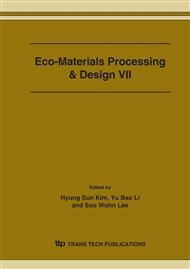p.38
p.42
p.46
p.50
p.54
p.58
p.62
p.66
p.70
Correlation of Superhydrophilicity and Photocatalytic Activity in the TiO2-Based Porous Thin Films
Abstract:
Transparent TiO2, WO3-TiO2, and MoO3-TiO2 films were prepared by spin-coating each colloidal suspension. The monolayer coverage of WO3 on the surface of TiO2 greatly increased the photocatalytic activity in the decomposition of gaseous 2-propanol, whereas the addition of MoO3 considerably decreased the photocatalytic reaction of TiO2. For the estimation of superhydrophilicity, the change of contact angles between the water drop and the film surface was measured as a function of UV-irradiation time. The measured contact angle of WO3-TiO2 film was considerably lower than that of TiO2 before the UV-irradiation, and it decreased to the minimum value about 4 times faster than that of pure TiO2 films with the irradiation of UV light. On the other hand, MoO3-TiO2 films showed a low contact angle at initial point, but their contact angle was very slowly decreased under the UV light. The initial low contact angles suggest the high hydrophilic character of WO3-TiO2 and MoO3-TiO2 films with high Lewis surface acidities. The observed trend suggests that the superhydrophilicity is closely related to the photocatalytic activity.
Info:
Periodical:
Pages:
54-57
Citation:
Online since:
March 2006
Authors:
Keywords:
Price:
Сopyright:
© 2006 Trans Tech Publications Ltd. All Rights Reserved
Share:
Citation:


